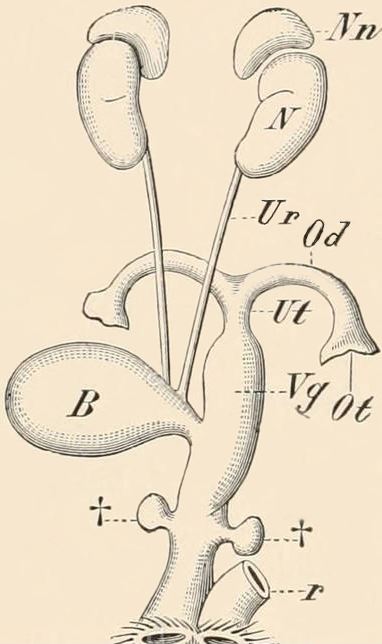Sometimes hedgehog UTI symptoms may be a sign of something else. A urinary tract infection (UTI) can effect any part of a hedgehog's urinary tract, including the bladder, urethra, and kidneys. Most hedgie UTI symptoms can be treated with antibiotics, so it is important for your vet to determine what bacterial strain is present. If it is a virus, antibiotics will not be able to help. Read on and we will let you know the signs, causes, and treatments of a UTI in hedgehogs. Also, we have some suggestions for you to discuss with your vet when this issue presents itself.
Medical disclaimer: All information provided is carefully researched. However, this information is not intended to replace medical advice from an experienced hedgehog veterinarian. The following is a collection of medical resources and community experiences with hedgehog UTI's. The intention of this information is to give you a solid foundation of topics to discuss with your vet. We aim to work together with vets, breeders, scientists, and all those who care about hedgehogs to improve their life span and quality of life. This information is to help you and your vet diagnose and treat your hedgehog's discomfort sooner.
Signs of a Hedgehog UTI
The first sign may be an undetectable one, and that is any sounds or signs of distress your hedgehog may make while urinating. They may expel small bouts of urine frequently and slowly. The appearance of the urine may be red or cloudy and have a strong odor [see here for an example]. Another sign would be constant attention to their genitalia, so watch for self mutilation or what you may believe to be excessive masturbation [Example of what that can look like here]. And lastly, which is the most noticeable and shocking: blood in the urine [see example here].
This is one of the reasons why the hedgehog community uses lightly colored bedding, to watch for abnormalities. Appearance of bloody urine may be present on their wheel or even in the bath water. It can range from light pink to dark red and there should not be more than a few drops of it. Appetite may suffer as well, and your hedgehog may become lethargic. However, A hedgie could also show no signs of appetite loss or lethargy and still have a UTI. The main focus is to catch it early on when you notice the frequent peeing in discomfort and in small quantities. Listen for the yelp. An untreated UTI can lead to cystitis, which is an inflammation of the uterus in females, Nephritis which is inflammation of the kidneys, or Urethritis which is the inflammation of the urethra.
Helping You Help Your Vet

Seeing blood in urine is always a sign to go to the vet. As is any other appearance of a UTI because it needs intervention. To help your vet determine a quicker diagnosis, use the above tip on obtaining a urine sample. Stool samples are important as well to bring in, just so they have more material to test. Ask your vet if they would be comfortable taking a sample directly from the bladder to rule out any other bacterial infections. Lab tests on the sample should determine the exact strain of bacteria present, which helps the vet prescribe the right antibiotic.
Before accepting an antibiotic, ask your vet about conducting an ultrasound and not an x-ray. If they resist, ask them why. According to UltraSound Schools Info, uterine tumors can be caught easier by ultrasounds. This is because ultrasounds analyze soft tissue and the pathology within. In contrast, x-rays help analyze hard tissue issues like bone fractures. Because of being less expensive though, x-rays are almost always first recommended. An x-ray could be a great tool, after the ultrasound has been done, to catch any dense obstructions.
What Causes a UTI In Hedgehogs?

B: Bladder Ur: Ureter N: Kidneys UT: Uterus
Bacterial Infection: UTI Reason #1
When foreign bacteria enters the urethra or bladder, that bacteria begins to multiply and work its way up their urinary tract. Their systems already have healthy bacteria inside. However, invading bacteria compromises its ability to fight infection. The bacteria can come from their fur, quills, their fecal matter, or anything that touches their urethra that is unclean. This is why litter training your hedgehog, as well as using safe bedding is a great preventative measure. If you'd like to learn about litter training, please click here.
Insufficient Hydration: UTI Reason #2
Insufficient water intake and low moisture levels in diets are other factors that have caused bladder infections. It is a good idea to start measuring the amount of water your hedgehog drinks. To help you do this, below is a recommended daily water intake chart for your hedgehog. Along with an increase in water intake, a change of food may also be needed. Ask your vet about changing your hedgehogs diet. A natural raw meal plan or simple ingredient cat food may be needed. Another form of healthy moisture is consumption of baby food squash, sweet potato, or pumpkin.
Other Environmental Factors: UTI Reason #3
- Foreign Objects: Urethral obstruction is a common and avoidable reason for discomfort that has caused hedgehog UTI symptoms. Pieces of bedding have been known to get caught inside the male penile sheath and inside of a female hedgehog's vulva. A daily inspection of those areas is encouraged.
- Males and Females Housed Together or Closely: Females are induced ovulators. The presence of a male hedgehog causes her reproductive cycle to start. This can irritate her urinary tract as a result.
- Cage Temperature: Make sure your hog is comfortable in a temperature controlled environment of 74°F – 80°F/23°C – 26.5°C
Other Possible Reasons For Blood in their Urine or Stools
Sometimes owners have completed the antibiotics but the UTI returns. It could very well mean a case of Pyometra. Pyometra is an infection of their uterus and involves surgery, and most likely removal of the uterus. Another cause may be uterine or bladder tumors, cystitis, polyps, stones, kidney disease, or even a systemic issue. Hedgehogs are also susceptible to internal and external parasites, so intestinal worms can also cause blood in their excretions.
RELATED:
Treatments That Have Been Prescribed For Hedgehog UTI Symptoms
| Prescription | Purpose |
| Trimethoprim | Fights urinary tract infections |
| Sulfatrim | Strongest antibacterial combination |
| Clavamox | Pain management |
| silver sulfadiazine ointment | To heal self mutilation scars and stop bacteria from spreading |
| gabapentin | Pain medication |
| cephalexin | Fights Staphylococcal infection and kidney infections |
Unsweetened cranberry juice from the grocery store is a natural remedy you can offer to them in their water dish. You may also try giving it to them in a syringe, making a puree with pumpkin in your food processor, or try to find a baby food with cranberries in it. Giving them a hot water bottle, safe heating pad, or wrapping a warm towel around them may provide comfort. A warm bath that contains baking soda or dissolved natural epsom salts can also provide relief of hedgehog UTI symptoms.
If UTI's are constantly reoccurring, then ask your vet about a probiotic instead to balance out the good and bad bacteria, just as mentioned here in this Cleveland Clinic's UTI article.
How to give your hedgehog their medicine through a syringe
If you were given an oral medication, here is a handy tutorial on how to feed your hedgehog their medicine through a syringe.
Summary of Hedgehog UTI Symptoms
First, your hedgehog may begin to pee more frequently in smaller amounts and yelp in discomfort. They may also pay more attention to genitalia by nibbling or licking the area. If you notice blood in your hedgehogs urine, then call the vet. You can facilitate a diagnosis if you collect a 1ml syringe full of your hedgie's urine. A combination of tests are your safest path to solving these symptoms as quickly as possible.
Tell the vet you would like a sample of their urine tested by a lab for bacterial presence. If bacteria is detected, then an appropriate antibiotic should be prescribed. Additionally, request an ultrasound to determine if any masses exist. If the first two tests show nothing, an x-ray would be appropriate, since kidney stones are a possibility. If none of these yield anything, too much bad bacteria is a likely culprit. Your vet may be willing to obtain a swab of bacterial culture to be analyzed. If there is an imbalance in bad versus good bacteria, then a probiotic may be needed.
Remember to give your hedgie the full antibiotic treatment that your doctor prescribes. Urinary tract infections may return or be a sign of something more serious. We hope that you now have a lot of information to work with your hedgehog's vet. Remember, always ask questions and don't be afraid to respectfully challenge decisions when you feel something isn't right.
RELATED:







Seeing normal urine color darken can be caused by a new food but should return to normal within 24 hours. If urine remains darker than normal into 48 hours it should be checked then. Darker than normal urine is the earliest sign I always see of blood in urine. This happens often before bleeding naked eyes can see as blood in the urine.
Thank you for your experienced input Amber. As always, your observations and insight are appreciated!